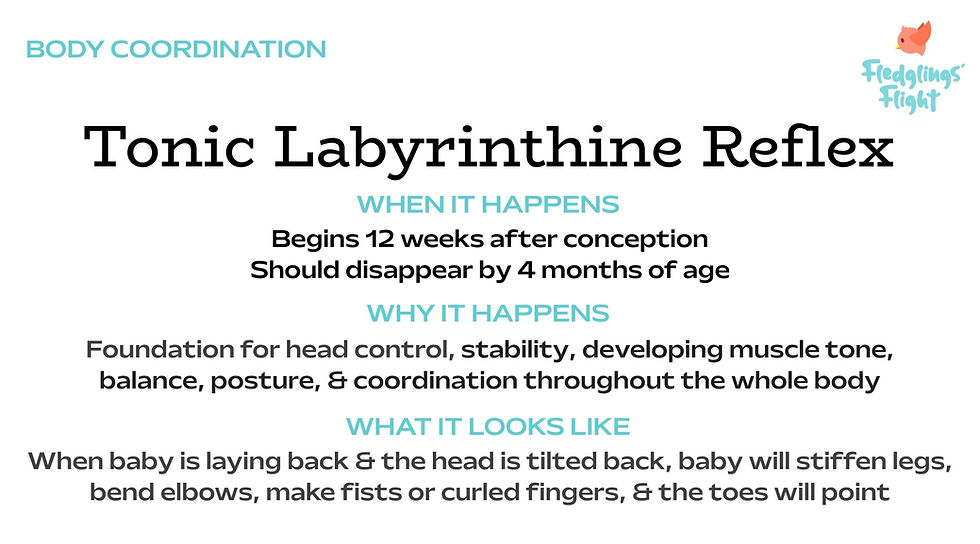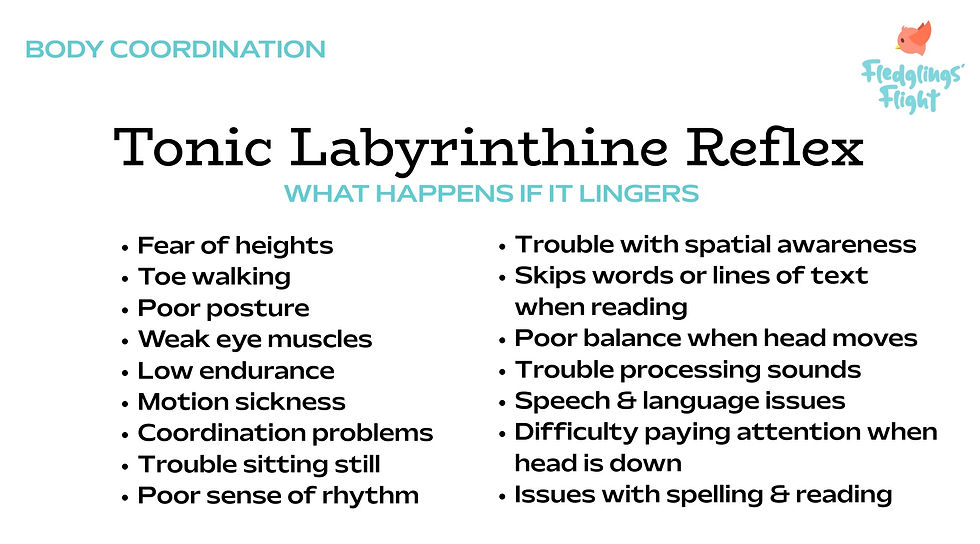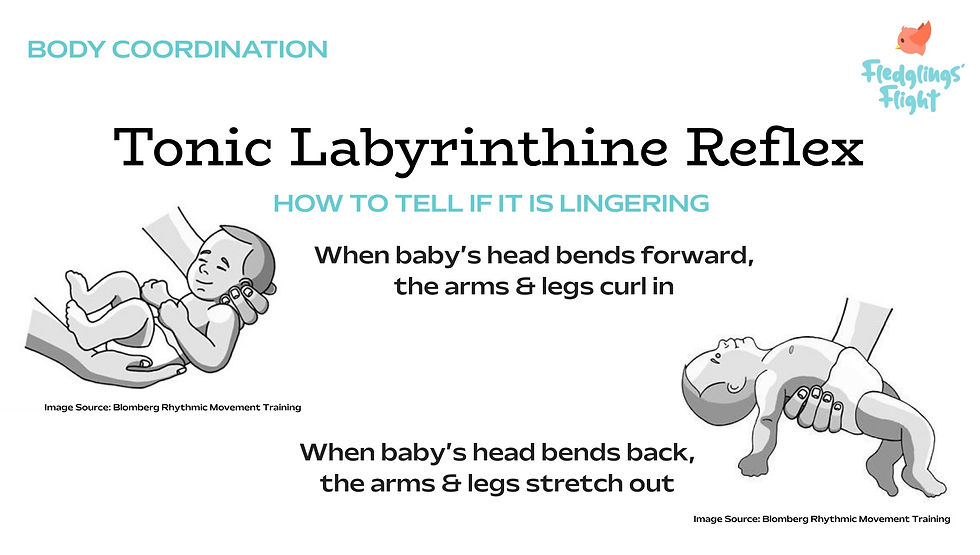Balancing Act: How the Tonic Labyrinthine Reflex Shapes Balance, Posture, and More
- Kaylie Estrada
- Sep 9, 2025
- 4 min read
Updated: Oct 2, 2025
The Tonic Labyrinthine Reflex helps baby’s body straighten or curl when their head moves.

What are primitive reflexes?
Primitive reflexes are instinctive responses that babies are born with. These reflexes develop before birth and prepare infants for life outside the womb. They work to provide the building blocks for survival and development by helping babies establish the foundations for movement and coordination. Each reflex contributes to a specific aspect of growth and eventually fades as they gain control over their bodies.
The different primitive reflexes all play a role in setting the foundation for balance, posture, and motor control. The Asymmetric Tonic Neck Reflex (ATNR) helps with coordinating the left and right sides of the body. The Symmetrical Tonic Neck Reflex (STNR) is most often called the crawling reflex and helps babies separate upper and lower body movements. The Galant Reflex helps with crawling motions and body awareness. The Tonic Labyrinthine Reflex (TLR) which we will be going over, plays a direct roll in stability, head control, and body alignment. These reflexes work together to help your baby survive, navigate their environments, and build the foundation for voluntary, controlled movements.

What is the Tonic Labyrinthine Reflex?
The Tonic Labyrinthine Reflex is triggered with changes in head position. When your baby tilts their head backward, their body will respond by automatically stiffening the legs, bending their elbows, pointing the toes, and curling their fingers into fists. The opposite happens when their head bends forward, their arms and legs pull inward toward their body. These movements are important in helping babies develop stability and even muscle tone. The TLR also helps them learn to move their bodies against gravity, which is
essential for gaining head control and eventually even more complex movements.
Because the TLR connects the head position with body movement, it also has a big influence on a child's sense of balance and spatial orientation. As your baby grows and the reflex fades, they will gain more voluntary control of their body, allowing them to move around smoothly and explore their environments with confidence!

What happens if the Tonic Labyrinthine Reflex Lingers?
When the TLR remains active beyond 4 months, it can interfere with a baby's physical and cognitive growth. Children with a retained TLR might show signs of poor posture and they may show signs of toe walking or tire quickly due to low endurance. Balance and coordination might also be affected, which can make running, climbing, or participating in sports more of a challenge. The influence of the TLR involves more than just physical skills, but also extends to things like learning. Children may struggle with spatial awareness, making it hard to judge distances. Weak integration of the reflex has also been linked to difficulty spelling and skipping words or lines while reading, which might even lead to potential strain on the eye muscles. Inattention, restlessness, and challenges with processing auditory information may also show up, all of which can make focusing in school more difficult. Normally, this reflex should fade as your baby gains control over their body and learns to hold themselves up.

How to test for a retained Asymmetric Tonic Neck Reflex
As Healthline explains, to see if your baby's TLR reflex is till active, "... lay your baby on their back and tilt their head forward above the level of the spine—see their arms and legs curl in? For the backward TLR, tilt their head backward below the level of the spine and watch their arms and legs flail out," [3]. These responses are typical in early infancy and serve their purpose during the first months of life. However, as the baby develops voluntary head control and stronger postural muscles, the reflex should fade; usually around the four month mark. Its disappearance allows for smoother, more controlled movement and allows for your baby to focus and learn even more skills.

What can you do about a retained Asymmetric Tonic Neck Reflex?
If you suspect that your child’s TLR is lingering, awareness and observation are always the first steps. Pediatricians and specialists, can help to see whether the reflex is still present and recommend exercises or therapies that can aid in the integration of this reflex. Early intervention is important, because the longer a reflex persists, the more it may interfere with other motor skills like learning, and behavior. With the right support, children can overcome challenges that may be caused by lingering TLR. Recognizing and addressing such things ensures that children can build a strong foundation for both physical development even academic success in the future.
Sources:
Lewis, R. (2020, May 19). What are the primitive reflexes and how are they useful? Healthline. https://www.healthline.com/health/baby/primitive-reflexes?utm
Brain Balance Centers. Retained Primitive Reflexes as a Sign of Brain Imbalance. https://www.brainbalancecenters.com/blog/retained-primitive-reflexes-sign-brain-imbalance
Understanding Primitive Reflexes: A Dynamic Perspective on Sensory Motor Development. (n.d.). Sensory Health. https://sensoryhealth.org/node/2060

Want more information like this?
Create a free account with Fledglings' Flight and get access to 4820 screen-free, play-based exercises. That is 100-200 exercises each month that you can start doing with your baby from the day that they are born to help them to develop into the best version of themselves. In addition, your free account gives you access to 1200+ articles on child development to keep you informed while you help to navigate your child's developmental journey.




Comments